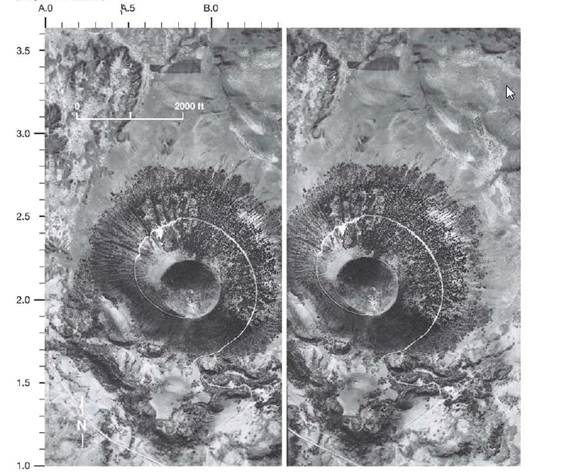
Obtain a stereoscope from your instructor, unfold it, and center it over the line that separates the two serial photographs of the volcanic core in figure 7.2. Use this stereogram to complete the following.
Figure 7.2 Stereogram of Mt. Capulin, a volcanic cinder cone located in northeastern New Mexico. The stereogram consists of two overlapping aerial photographs taken from an altitude of approximately 4800 meters (16,000 feet). To view the three-dimensional image of the volcano, center a stereoscope over the line that separates the two photographs. Then, while looking through the stereoscope, adjust the stereoscope until the image appears in three dimensions. The inset photo shows a traditional ground-level view of Mt. Capulin.

Identify and label the crater at the summit of the volcano.
Learn your wayIncludes step-by-step video

Chapter 7 Solutions
Applications and Investigations in Earth Science (9th Edition)
Additional Science Textbook Solutions
Human Biology: Concepts and Current Issues (8th Edition)
Genetic Analysis: An Integrated Approach (3rd Edition)
Living By Chemistry: First Edition Textbook
Physics for Scientists and Engineers: A Strategic Approach, Vol. 1 (Chs 1-21) (4th Edition)
Organic Chemistry (8th Edition)
Microbiology: An Introduction
- Why is the Atlantic Ocean the saltiest ocean on Earth? In your explanation, use the terms “evaporation,” “precipitation,” “trade winds,” “Central America,” and “Pacific Ocean”.?arrow_forwardAt the large scale of the major ocean basins, do ocean currents tend to flow in a cyclonic or anti-cyclonic direction? How is this evidenced in the map of average sea-surface temperatures belowarrow_forwardThe map below shows sea-surface temperature (SST) anomalies during El Niño years. Please explain what is meant by “anomaly”. In El Niño years, which side (east or west) of the tropical Pacific Ocean experiences anomalously high precipitation totals and which side experiences anomalously low precipitation totals? Why?arrow_forward
- When a body of cold air near earth’s surface moves into a region occupied by warmer air, the point of intersection is known as a cold front. What does this do to the vertical motion of the warm air and why? What does this do to surface pressure ahead of the cold front and why ?Does this tend to instigate cyclonic or anti-cyclonic atmospheric rotation ? Does this rotation tend to bring relatively warm air toward the poles or toward the lower latitudesarrow_forwardAs the atmosphere and ocean move, they are deflected due to the spin of the earth. Is the deflection to the right or to the left in the Northern Hemisphere? Is this the same in the Southern Hemisphere ? In both hemispheres, a low pressure will instigate cyclonic flow. In the Northern Hemisphere, does cyclonic flow circulate in a clockwise or counter-clockwise direction and whyarrow_forwardIs the seasonal cycle in temperature (temperature difference between warmest and coolest season) stronger in the tropics or high latitudes, and why ?How about in “maritime” areas that are regularly exposed to air that was recently over the ocean versus more continental areas, and why?arrow_forward
- The image shows the two different crusts on earth. Fill in the blanks with short answers (numbered as 1,2,3, and 4) for the rock types and the name of the crust. Question 3 options: Blank # 1 Blank # 2 Blank # 3 Blank # 4arrow_forwardyou are working on a crew and you overhear one of the people on the crew tell a member of the general public something that is not true. what do you do?arrow_forwardResearch question ideas for Benthic invertebrates as an indicator species for climate change, mapping changes in ecosystems (Historical Analysis & GIS) use where questionsarrow_forward
- Research question ideas for Benthic invertebrates as an indicator species for climate change, mapping changes in ecosystems (Historical Analysis & GIS) use where questionsarrow_forwardBrief background for supporting of efforts should be made to create distance and separate crops that produce pollutants such as ecoli (i.e. animal farming) from crops that don’t (i.e. lettuce) to protect these latter crops despite the extra costs and logistical challenges.arrow_forwardOpening statement for supporting of efforts should be made to create distance and separate crops that produce pollutants such as ecoli (i.e. animal farming) from crops that don’t (i.e. lettuce) to protect these lattercrops despite the extra costs and logistical challenges.arrow_forward
 Applications and Investigations in Earth Science ...Earth ScienceISBN:9780134746241Author:Edward J. Tarbuck, Frederick K. Lutgens, Dennis G. TasaPublisher:PEARSON
Applications and Investigations in Earth Science ...Earth ScienceISBN:9780134746241Author:Edward J. Tarbuck, Frederick K. Lutgens, Dennis G. TasaPublisher:PEARSON Exercises for Weather & Climate (9th Edition)Earth ScienceISBN:9780134041360Author:Greg CarbonePublisher:PEARSON
Exercises for Weather & Climate (9th Edition)Earth ScienceISBN:9780134041360Author:Greg CarbonePublisher:PEARSON Environmental ScienceEarth ScienceISBN:9781260153125Author:William P Cunningham Prof., Mary Ann Cunningham ProfessorPublisher:McGraw-Hill Education
Environmental ScienceEarth ScienceISBN:9781260153125Author:William P Cunningham Prof., Mary Ann Cunningham ProfessorPublisher:McGraw-Hill Education Earth Science (15th Edition)Earth ScienceISBN:9780134543536Author:Edward J. Tarbuck, Frederick K. Lutgens, Dennis G. TasaPublisher:PEARSON
Earth Science (15th Edition)Earth ScienceISBN:9780134543536Author:Edward J. Tarbuck, Frederick K. Lutgens, Dennis G. TasaPublisher:PEARSON Environmental Science (MindTap Course List)Earth ScienceISBN:9781337569613Author:G. Tyler Miller, Scott SpoolmanPublisher:Cengage Learning
Environmental Science (MindTap Course List)Earth ScienceISBN:9781337569613Author:G. Tyler Miller, Scott SpoolmanPublisher:Cengage Learning Physical GeologyEarth ScienceISBN:9781259916823Author:Plummer, Charles C., CARLSON, Diane H., Hammersley, LisaPublisher:Mcgraw-hill Education,
Physical GeologyEarth ScienceISBN:9781259916823Author:Plummer, Charles C., CARLSON, Diane H., Hammersley, LisaPublisher:Mcgraw-hill Education,





